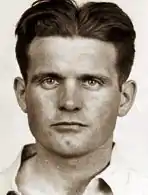Edward Kerling
Edward John Kerling (June 12, 1909 - August 8, 1942) was a spy and saboteur for Nazi Germany and leader of Operation Pastorius during World War II.
Edward John Kerling | |
|---|---|
 FBI mugshot | |
| Born | 12 June 1909 |
| Died | 8 August 1942 (aged 33) D.C. Jail, Washington, D.C., U.S. |
| Cause of death | Execution by electrocution |
| Burial place | Washington Asylum Potters Field |
| Nationality | German |
| Other names | Eddie Kerling |
| Citizenship |
|
| Occupation |
|
| Known for | Spying for Nazi Germany |
| Criminal charge(s) | Espionage Sabotage |
| Criminal penalty | Death by electrocution |
| Criminal status | Deceased |
| Spouse(s) | Marie Sighard |
| Espionage activity | |
| Allegiance | |
| Agency | Reich Ministry of Public Enlightenment and Propaganda |
| Service years | 1940-1942 |
| Operations | Pastorius |
Early life
Born in Biebrich, Wiesbaden, German Empire, Kerling was the son of Kasper and Walberoa Kerling. His father, Kasper, was a World War I Imperial German Army veteran. Kerling studied engineering at the University of Freiburg. After leaving school, he went to the U.S. and over the next several years worked a myriad of jobs. He married Marie Sighard in 1931. Kerling and Sighard frequently travelled back to Germany throughout the years to visit their families.[1]
World War II
In the summer of 1940, Kerling once more returned to Germany to look for work. He received a position within the Wehrmacht translating English broadcasts into German. He was sent to France for the duration of the project and returned to Berlin after three months. Upon returning, Kerling was given a position with the Reich Ministry of Public Enlightenment and Propaganda managing German theatres. He remained with the Propaganda Ministry for the next two years until Walter Kappe offered him the chance to return to the U.S. on a military mission. After a short time Kerling accepted the offer and spent the next several weeks training and becoming acquainted with other members of the mission. He spent a great deal of time with his parents during this period.[1]
Operation Pastorius
Operation Pastorius consisted of 12 Germans who were fluent in English. They were trained as secret agents at the Brandenburg School of Sabotage. Upon graduation they were sent to the U.S. via U-Boat in an attempt to damage infrastructure and industries vital to the American war effort. Kerling's group landed on Ponte Vedra Beach, Florida on June 17, 1942.[1]
Kerling was arrested by the Federal Bureau of Investigation on June 23, 1942. It was revealed that two members of the other group, George Dasch and Ernst Burger, betrayed the entire operation and alerted federal authorities of their intentions.[2]
Trial and death
Kerling and the seven others involved were sent to Washington, D.C., where they were to face a military tribunal. All were convicted of being enemy agents and, even though they had not yet carried out any sabotage, six — including Kerling — were sentenced to death.[3] Dasch and Burger received long prison sentences which were eventually commuted to deportation after the war.[2]
Kerling and the remaining five, Herbert Hans Haupt, Henry Harm Heinck, Hermann Otto Neubauer, Richard Quirin, and Werner Thiel were all executed on August 8, 1942 in the District of Columbia's electric chair.[4] It was the largest mass execution via electrocution ever conducted. Kerling and the others were buried in the Potter's Field in Blue Plains. The graves were originally marked by boards with numbers until a German-American organization placed a small monument commemorating their lives.[2]
Citations
- Kerling, Edward; Kerling's Confession
- FBI, National Socialist Saboteurs
- Ex Parte Quirin
- National Socialist Saboteur Trial
References used
- Kerling, Edward. "Kerling's Confession". twin-cities-umn.edu. Retrieved 23 October 2020.</ref>
- "National Socialist Saboteurs". fbi.gov. Retrieved 24 October 2020.
- "Ex Parte Quirin". law.cornell.edu. Retrieved 24 October 2020.
- "National Socialist Saboteur Trial". loc.gov. Retrieved 24 October 2020.